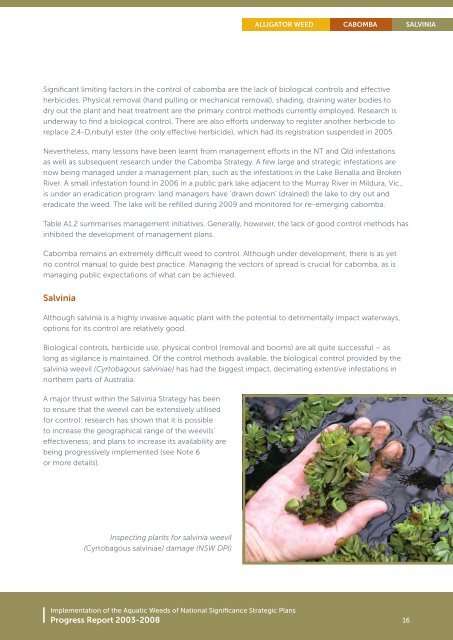implementation of the aquatic Weeds of national ... - Weeds Australia
implementation of the aquatic Weeds of national ... - Weeds Australia
implementation of the aquatic Weeds of national ... - Weeds Australia
You also want an ePaper? Increase the reach of your titles
YUMPU automatically turns print PDFs into web optimized ePapers that Google loves.
Alligator Weed<br />
Cabomba<br />
Salvinia<br />
Significant limiting factors in <strong>the</strong> control <strong>of</strong> cabomba are <strong>the</strong> lack <strong>of</strong> biological controls and effective<br />
herbicides. Physical removal (hand pulling or mechanical removal), shading, draining water bodies to<br />
dry out <strong>the</strong> plant and heat treatment are <strong>the</strong> primary control methods currently employed. Research is<br />
underway to find a biological control. There are also efforts underway to register ano<strong>the</strong>r herbicide to<br />
replace 2,4-D,nbutyl ester (<strong>the</strong> only effective herbicide), which had its registration suspended in 2005.<br />
Never<strong>the</strong>less, many lessons have been learnt from management efforts in <strong>the</strong> NT and Qld infestations<br />
as well as subsequent research under <strong>the</strong> Cabomba Strategy. A few large and strategic infestations are<br />
now being managed under a management plan, such as <strong>the</strong> infestations in <strong>the</strong> Lake Benalla and Broken<br />
River. A small infestation found in 2006 in a public park lake adjacent to <strong>the</strong> Murray River in Mildura, Vic.,<br />
is under an eradication program: land managers have ‘drawn down’ (drained) <strong>the</strong> lake to dry out and<br />
eradicate <strong>the</strong> weed. The lake will be refilled during 2009 and monitored for re-emerging cabomba.<br />
Table A1.2 summarises management initiatives. Generally, however, <strong>the</strong> lack <strong>of</strong> good control methods has<br />
inhibited <strong>the</strong> development <strong>of</strong> management plans.<br />
Cabomba remains an extremely difficult weed to control. Although under development, <strong>the</strong>re is as yet<br />
no control manual to guide best practice. Managing <strong>the</strong> vectors <strong>of</strong> spread is crucial for cabomba, as is<br />
managing public expectations <strong>of</strong> what can be achieved.<br />
Salvinia<br />
Although salvinia is a highly invasive <strong>aquatic</strong> plant with <strong>the</strong> potential to detrimentally impact waterways,<br />
options for its control are relatively good.<br />
Biological controls, herbicide use, physical control (removal and booms) are all quite successful – as<br />
long as vigilance is maintained. Of <strong>the</strong> control methods available, <strong>the</strong> biological control provided by <strong>the</strong><br />
salvinia weevil (Cyrtobagous salviniae) has had <strong>the</strong> biggest impact, decimating extensive infestations in<br />
nor<strong>the</strong>rn parts <strong>of</strong> <strong>Australia</strong>.<br />
A major thrust within <strong>the</strong> Salvinia Strategy has been<br />
to ensure that <strong>the</strong> weevil can be extensively utilised<br />
for control: research has shown that it is possible<br />
to increase <strong>the</strong> geographical range <strong>of</strong> <strong>the</strong> weevils’<br />
effectiveness; and plans to increase its availability are<br />
being progressively implemented (see Note 6<br />
or more details).<br />
Inspecting plants for salvinia weevil<br />
(Cyrtobagous salviniae) damage (NSW DPI)<br />
Implementation <strong>of</strong> <strong>the</strong> Aquatic <strong>Weeds</strong> <strong>of</strong> National Significance Strategic Plans<br />
Progress Report 2003-2008<br />
16

















